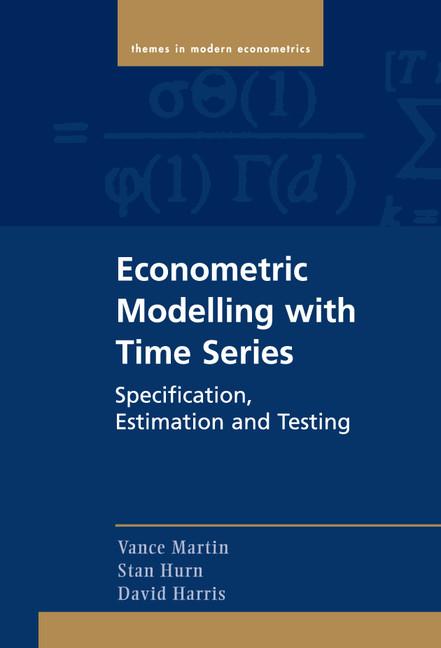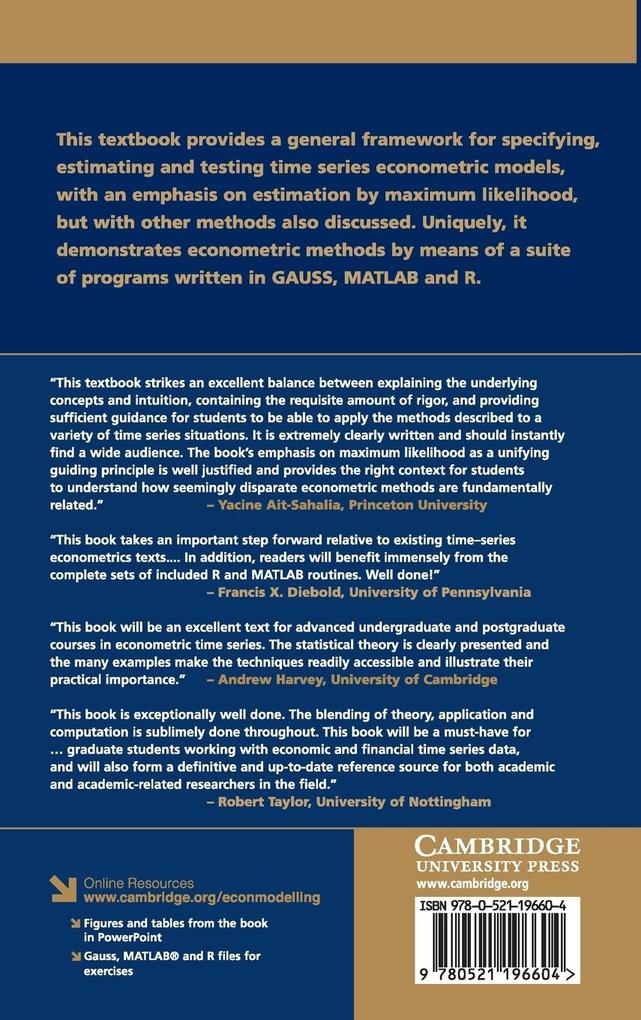
Zustellung: Mi, 04.06. - Sa, 07.06.
Versand in 1-2 Wochen
VersandkostenfreiBestellen & in Filiale abholen:
This book provides a general framework for specifying, estimating and testing time series econometric models.
Inhaltsverzeichnis
Part I. Maximum Likelihood: 1. The maximum likelihood principle; 2. Properties of maximum likelihood estimators; 3. Numerical estimation methods; 4. Hypothesis testing; Part II. Regression Models: 5. Linear regression models; 6. Nonlinear regression models; 7. Autocorrelated regression models; 8. Heteroskedastic regression models; Part III. Other Estimation Methods: 9. Quasi-maximum likelihood estimation; 10. Generalized method of moments; 11. Nonparametric estimation; 12. Estimation by stimulation; Part IV. Stationary Time Series: 13. Linear time series models; 14. Structural vector autoregressions; 15. Latent factor models; Part V. Non-Stationary Time Series: 16. Nonstationary distribution theory; 17. Unit root testing; 18. Cointegration; Part VI. Nonlinear Time Series: 19. Nonlinearities in mean; 20. Nonlinearities in variance; 21. Discrete time series models; Appendix A. Change in variable in probability density functions; Appendix B. The lag operator; Appendix C. FIML estimation of a structural model; Appendix D. Additional nonparametric results.
Produktdetails
Erscheinungsdatum
06. Februar 2015
Sprache
englisch
Seitenanzahl
924
Autor/Autorin
Vance Martin, Stan Hurn, David Harris
Verlag/Hersteller
Produktart
gebunden
Gewicht
1461 g
Größe (L/B/H)
235/157/54 mm
ISBN
9780521196604
Entdecken Sie mehr
Pressestimmen
'This book will be an excellent text for advanced undergraduate and postgraduate courses in econometric time series. The statistical theory is clearly presented and the many examples make the techniques readily accessible and illustrate their practical importance.' Andrew Harvey, University of Cambridge 'This book takes an important step forward relative to existing time-series econometrics texts, with, for example, significant coverage of numerical optimization, quasi-maximum-likelihood estimation, nonparametric and simulation-based estimation, latent-factor models, and volatility models. In addition, readers will benefit immensely from the complete sets of included R and Matlab routines. Well done!' Francis X. Diebold, University of Pennsylvania 'This book is exceptionally well done. The blending of theory, application and computation is sublimely done throughout. [It] will be a must-have for advanced graduate students working with economic and financial time series data, and will also form a definitive and up-to-date reference source for both academic and academic-related researchers in the field.' Robert Taylor, University of Nottingham 'This book gave me excitement and sensations similar to visiting Australian wineries: tantalizing vitality, pronounced yet balanced flavours, exposing exhilarating progressive developments, produced by excellent and tasteful craftsmanship, and well-matured and extremely consumer-friendly with its many recipes in various computer codes, thus it is strongly recommended to both young graduates and experienced connoisseurs.' Jan F. Kiviet, Nanyang Technological University and University of Amsterdam Advance praise: 'This textbook strikes an excellent balance between explaining the underlying concepts and intuition, containing the requisite amount of rigor, and providing sufficient guidance for students to be able to apply the methods described to a variety of time-series situations. It is extremely clearly written and should instantly find a wide audience. The book's emphasis on maximum-likelihood as a unifying guiding principle is well-justified, and provides the right context for students to understand how seemingly disparate econometric methods are fundamentally related.' Yacine Ait-Sahalia, Princeton University
Bewertungen
0 Bewertungen
Es wurden noch keine Bewertungen abgegeben. Schreiben Sie die erste Bewertung zu "Econometric Modelling with Time Series" und helfen Sie damit anderen bei der Kaufentscheidung.











